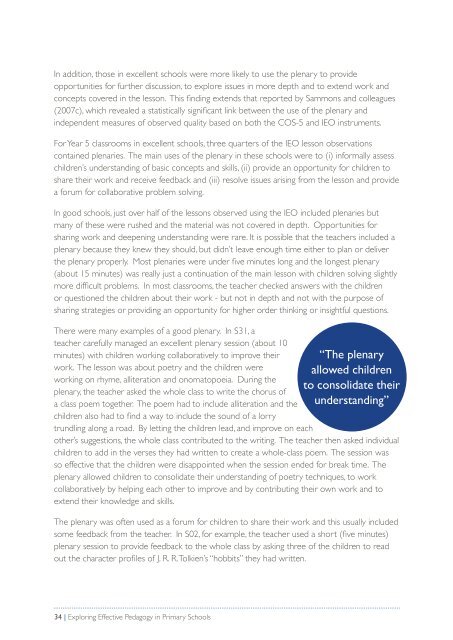Pearson-Exploring-Effective-Pedagogy-in-Primary-Schools
Pearson-Exploring-Effective-Pedagogy-in-Primary-Schools
Pearson-Exploring-Effective-Pedagogy-in-Primary-Schools
You also want an ePaper? Increase the reach of your titles
YUMPU automatically turns print PDFs into web optimized ePapers that Google loves.
In addition, those <strong>in</strong> excellent schools were more likely to use the plenary to provideopportunities for further discussion, to explore issues <strong>in</strong> more depth and to extend work andconcepts covered <strong>in</strong> the lesson. This f<strong>in</strong>d<strong>in</strong>g extends that reported by Sammons and colleagues(2007c), which revealed a statistically significant l<strong>in</strong>k between the use of the plenary and<strong>in</strong>dependent measures of observed quality based on both the COS-5 and IEO <strong>in</strong>struments.For Year 5 classrooms <strong>in</strong> excellent schools, three quarters of the IEO lesson observationsconta<strong>in</strong>ed plenaries. The ma<strong>in</strong> uses of the plenary <strong>in</strong> these schools were to (i) <strong>in</strong>formally assesschildren’s understand<strong>in</strong>g of basic concepts and skills, (ii) provide an opportunity for children toshare their work and receive feedback and (iii) resolve issues aris<strong>in</strong>g from the lesson and providea forum for collaborative problem solv<strong>in</strong>g.In good schools, just over half of the lessons observed us<strong>in</strong>g the IEO <strong>in</strong>cluded plenaries butmany of these were rushed and the material was not covered <strong>in</strong> depth. Opportunities forshar<strong>in</strong>g work and deepen<strong>in</strong>g understand<strong>in</strong>g were rare. It is possible that the teachers <strong>in</strong>cluded aplenary because they knew they should, but didn’t leave enough time either to plan or deliverthe plenary properly. Most plenaries were under five m<strong>in</strong>utes long and the longest plenary(about 15 m<strong>in</strong>utes) was really just a cont<strong>in</strong>uation of the ma<strong>in</strong> lesson with children solv<strong>in</strong>g slightlymore difficult problems. In most classrooms, the teacher checked answers with the childrenor questioned the children about their work - but not <strong>in</strong> depth and not with the purpose ofshar<strong>in</strong>g strategies or provid<strong>in</strong>g an opportunity for higher order th<strong>in</strong>k<strong>in</strong>g or <strong>in</strong>sightful questions.There were many examples of a good plenary. In S31, ateacher carefully managed an excellent plenary session (about 10m<strong>in</strong>utes) with children work<strong>in</strong>g collaboratively to improve theirwork. The lesson was about poetry and the children werework<strong>in</strong>g on rhyme, alliteration and onomatopoeia. Dur<strong>in</strong>g theplenary, the teacher asked the whole class to write the chorus ofa class poem together. The poem had to <strong>in</strong>clude alliteration and thechildren also had to f<strong>in</strong>d a way to <strong>in</strong>clude the sound of a lorrytrundl<strong>in</strong>g along a road. By lett<strong>in</strong>g the children lead, and improve on each“The plenaryallowed childrento consolidate theirunderstand<strong>in</strong>g”other’s suggestions, the whole class contributed to the writ<strong>in</strong>g. The teacher then asked <strong>in</strong>dividualchildren to add <strong>in</strong> the verses they had written to create a whole-class poem. The session wasso effective that the children were disappo<strong>in</strong>ted when the session ended for break time. Theplenary allowed children to consolidate their understand<strong>in</strong>g of poetry techniques, to workcollaboratively by help<strong>in</strong>g each other to improve and by contribut<strong>in</strong>g their own work and toextend their knowledge and skills.The plenary was often used as a forum for children to share their work and this usually <strong>in</strong>cludedsome feedback from the teacher. In S02, for example, the teacher used a short (five m<strong>in</strong>utes)plenary session to provide feedback to the whole class by ask<strong>in</strong>g three of the children to readout the character profiles of J. R. R. Tolkien’s “hobbits” they had written.34 | <strong>Explor<strong>in</strong>g</strong> <strong>Effective</strong> <strong>Pedagogy</strong> <strong>in</strong> <strong>Primary</strong> <strong>Schools</strong>


